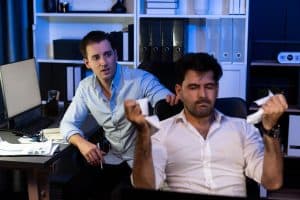Estimated reading time: 7 minutes
Key Takeaways
- Post-pandemic workplace loneliness is rising as hybrid and remote models limit spontaneous social interaction.
- Isolation hurts mental health, engagement, and overall productivity.
- Intentional culture-building, digital tools, and leadership empathy can reconnect dispersed teams.
- Outsourced well-being services and flexible workplace strategies accelerate support efforts.
- A connected workforce drives resilience, innovation, and long-term organisational success.
Table of Contents
Introduction
“I feel like I work with people, but not among people anymore.” This candid remark from a project manager sums up the creeping sense of disconnection many employees report in 2024. According to Harvard Business Review, loneliness has surged as face-to-face moments vanished overnight. In this post we unpack why workplace isolation intensified after COVID-19 and how leaders can rebuild connection without sacrificing flexibility.
Causes of Workplace Loneliness
Remote Work & Virtual Teams
Daily hallway chats turned into scheduled calls, stripping away the effortless “micro-connections” that nurture trust. While productivity apps keep projects on track, they rarely replicate the warmth of spontaneous banter.
Organisational Culture Shifts
Rapid digital transformation forced companies to prioritise logistics over culture. Many traditions—birthday cakes, team lunches, Friday socials—fell by the wayside, eroding the rituals that once bonded colleagues.
Prolonged Isolation
A Society for Human Resource Management study found that 1 in 3 remote workers now feel “persistently lonely,” even when meeting quotas. Virtual presence cannot fully substitute for meaningful, in-person bonding.
Impacts of Workplace Loneliness
Employee Well-Being & Mental Health
Isolation correlates with higher stress, anxiety, and even cardiovascular risk. An American Psychological Association meta-analysis equates chronic loneliness to smoking 15 cigarettes a day.
Psychological Impact on Engagement
Disconnected employees are 2x more likely to disengage, fuelling absenteeism and turnover. Motivation drops when people feel unseen or undervalued.
Organisational Productivity
Team synergy suffers when members hesitate to brainstorm freely or ask for help. Gallup estimates that lonely employees cost U.S. companies up to $406 billion annually in lost productivity.
Addressing Workplace Loneliness
Enhancing Employee Engagement
- Host weekly “camera-off” coffee breaks where conversation is strictly non-work.
- Rotate meeting facilitators to give every voice equal airtime.
Fostering Workplace Relationships
Create virtual spaces—Slack “water-cooler” channels or monthly hobby clubs—that encourage informal sharing. Leaders should model vulnerability by joining conversations and celebrating small wins.
Adjusting Organisational Culture
Support managers with training to spot loneliness cues: declining participation, muted cameras, or reduced initiative. Swift check-ins convey care and build psychological safety.
Solutions & Services
Outsourcing for Employee Well-Being
Specialist partners offer on-demand counselling, mindfulness workshops, and engagement analytics. Services like Headspace for Work integrate directly with HR platforms, delivering personalised support at scale.
Workplace Strategy Adjustments
Hybrid schedules that synchronise in-office days for entire teams cultivate richer rapport. Purposeful design—collaboration hubs, quiet zones, outdoor meeting areas—turns the office into a social magnet rather than a mandate.
Tools & Resources
- Wellness apps (Calm, Happify) with peer challenges.
- Virtual whiteboards (Miro, FigJam) that enable creative co-working.
- Pulse-survey platforms such as Perceptyx to measure connection in real time.
Conclusion
Workplace loneliness is no fleeting side effect of the pandemic—it’s a structural challenge that demands strategic response. By blending empathetic leadership, innovative technology, and an inclusive culture, organisations can convert isolation into intentional connection. Those that succeed will unlock higher engagement, stronger collaboration, and a healthier bottom line.
FAQ
How can managers spot signs of workplace loneliness?
Look for reduced participation, missed deadlines, or a shift from “video-on” to “video-off” behaviour. Private one-to-one check-ins often reveal underlying feelings.
Does returning to the office solve isolation?
Not automatically. Without deliberate culture-building, employees may feel lonely even in a crowded office. The quality—not quantity—of interaction matters.
What budget-friendly strategies combat loneliness?
Peer-led interest groups, shout-out channels, and rotating “virtual lunch buddies” cost little yet foster meaningful bonds.
Are mental health apps effective?
When paired with supportive leadership, apps provide valuable, just-in-time resources. Adoption rises when leaders share their own usage stories.
How do we measure progress?
Track eNPS (employee Net Promoter Score), pulse-survey connection metrics, and turnover rates. Improvement across these KPIs signals healthier social cohesion.







